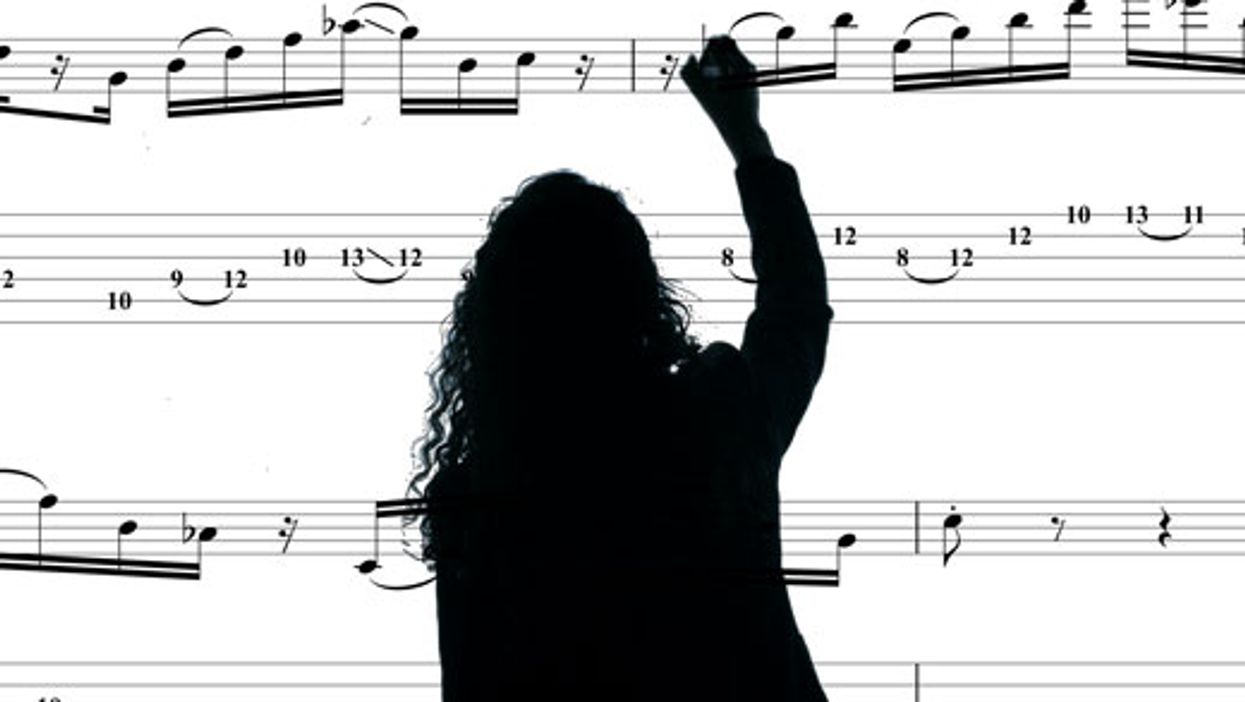Chops: Intermediate
Theory: Intermediate
Lesson Overview:
• Create drop-tuned riffs.
• Explore arpeggio sequences.
• Understand how to combine the minor pentatonic and Dorian scales.
Click here to download MP3s and a printable PDF of this lesson's notation.
Throughout rock history there have been many genre-defining power trios. For example, the Jimi Hendrix Experience, the Police, Rush, and Cream each created a unique and singular sound. The Texas-based trio King’s X helped shape the sound of hard rock by blending crushing altered-tuned riffs with soulful vocals, funky grooves, and Beatles-inspired psychedelic sounds. The trio of bassist Doug “dUg” Pinnick, guitarist Ty Tabor, and drummer Jerry Gaskill are all about groove and melody.
Hailing from Mississippi, Ty Tabor began playing guitar in his early teens, and was influenced by the Beatles, Alice Cooper, Brian May, and Phil Keaggy. His early musical experiences were playing and touring in his father’s bluegrass band. After Tabor joined up with Pinnick and Gaskill, the band relocated to Texas and met with Sam Taylor, who later became their manager and producer.
In 1989 the band released their landmark album, Gretchen Goes to Nebraska. This album contained such classic King’s X tracks as “Summerland,” “The Burning Down,” “Over My Head,” and the epic “Pleiades.” It was a turning point for the band, and the album’s success offered King’s X the opportunity to embark on large-scale arena support tours with such acts as AC/DC.
King’s X continues to record and release amazing albums and tour regularly. Each member also enjoys a successful solo career, as well as various side projects with members of Dream Theater, Pearl Jam, and the Dixie Dregs.
Ty Tabor is an incomparable guitarist. He uses a variety of altered tunings, including the grunge-approved dropped-D and a custom dropped-B setup. Tabor’s approach to chord arpeggios emphasizes common tones, and he also makes great use of single-coil pickups in a hard rock setting.
King’s X is my favorite band of all time, and because Tabor has possibly had more impact on my playing than any other guitarist, this track was a joy to compose. I’ve focused on isolating elements of “Pleiades,” “It’s Love,” “Summerland,” “Over My Head,” “Faith Hope Love,” and “Dogman” for this lesson. Also, this whole piece is in dropped-D tuning, so make sure to tune that low 6th string down a whole-step.
Click here for Ex. 1
The track kicks off with an eight-measure verse progression that perfectly illustrates Tabor’s approach to arpeggios supported by a moving bass line. This results in a series of slash chords, based around the initial D5 chord. In the last few measures of this section, a three-against-four riff combines two open strings with an ascending line on the 5th string.
I pay tribute to ideas from “It’s Love,” “Faith Hope Love,” and “Dogman” in the next eight-measure section. The first two measures combine some sliding power chords over a syncopated open 5th string. We then move on to some grinding dropped-D chords before repeating the first two measures. Finally, this section ends with an ascending arpeggiated passage that sets up both the repeat and the variation that comes up next.
A double-time feel kicks in during the next four-measure riff. This is based around ideas drawn from “Over My Head” and uses a similar pattern of power chords against an open string. The twist comes during the last measure before the solo with a unison line that’s played with the bass ahead of the Bbm7 chord stabs.
The ripping solo combines Hendrix-style bends and double-stops with some over-the-top shredding. Things kick off with double-stops based around the D minor pentatonic (D–F–G–A–C) and D Dorian (D–E–F–G–A–B–C) scales. In the sixth measure of the solo, I pre-bend the C before launching into a furious legato passage. The trick here is to break it up into smaller pieces and play with a metronome. Take each group of slurred notes and work them out before connecting them.
Tabor’s original rig included an early ’80s Fender Elite Strat that featured a mid-boost circuit. His amps of choice were Gibson Lab Series, which were rack mounted and used only as a preamp. Those then ran into a Mesa/Boogie power amp. Currently, Tabor usually favors a Fractal Audio Systems Axe-FX running into a Randall RT2/50 power amp. For pedals, he uses a Line 6 DL-4 and a Seymour Duncan Pickup Booster.
This month’s track was recorded entirely using Cubasis, Steinberg’s iPad sequencer and recording software. For guitar and bass tones I used JamUp Pro with an Alesis iO Dock interface. I plugged in my Ernie Ball Music Man Axis Super Sport (on a single-coil setting), and then dialed up a Marshall JCM sound for the rhythm parts and a Mesa/Boogie sound for lead. On the solo, I added a touch of chorus and delay, and for the cleaner tones I simply backed down my guitar volume knob. The “acoustic” guitars on the backing track were produced with the piezo pickup on the Axis.








![Rig Rundown: AFI [2025]](https://www.premierguitar.com/media-library/youtube.jpg?id=62064741&width=1245&height=700&quality=70&coordinates=0%2C0%2C0%2C0)






